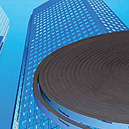What are BCF – Butyl Coated Foams?
- 8 June 2017
- Posted by: Madhuraka
- Category: Article
 On the surface, butyl coated foams are simply slightly tacky sealants. It’s when we cut into the material that the secret of this versatile water barrier is revealed. Outside, the butyl jacket creates a uniform finish. Inside, however, the foam core adds a compressible PVC backbone to the product. That’s an invaluable feature, and here’s why.
On the surface, butyl coated foams are simply slightly tacky sealants. It’s when we cut into the material that the secret of this versatile water barrier is revealed. Outside, the butyl jacket creates a uniform finish. Inside, however, the foam core adds a compressible PVC backbone to the product. That’s an invaluable feature, and here’s why.
Deconstructing Butyl Coated Foams
Designed to stop water from penetrating gaps in rigid doorways, the dual properties of a BCF sealant are easy to relate. Primarily, the butyl coating forms a weather-resistant barrier. Enter the PVC foam core, a central stratum that adds an important compressibility feature to the sealant. In essence, the foam-backed synthetic rubber keeps right on functioning when a rigid door slams closed. Cars or recreational vehicles, freezers or marine access ways, the twofold barrier won’t fail.
Seals Tricky Access Way Outlines
If we take a look at a modern car or even a newly introduced motorhome, the first thing we notice is all of that streamlined bodywork. Doors lie flush against the car chassis, numerous windows contour around the recreational vehicle, and there’s barely any sign of a break or line between the bodywork parts. Superb design skills and intricate latching mechanisms make those doors shut securely. Similarly, the windows snap shut with a solid click. Butyl coated foams (BCF) are required to maintain that sealing power, especially when those entry portals use heavy sealing mechanisms. The outer synthetic rubber conforms to the latching metal parts, contours around the intricate outlines of a sharp door corner, and fills every irregular gap. Meanwhile, as the door or window snaps shut, the PVC core compresses promptly while maintaining the integrity of the seal.
Maintaining the Sealing Double Act
A cross-section of the extruded tape shows off functionality. As mentioned before, the tacky butyl jacket stops water penetration. Then, if compressive forces are part of the door frame design, the seal calls on the inner foam core when the pressure ramps up. That’s because of the PolyVinyl Chloride core, a foam backbone that strengthens the product by adding elasticity and versatility to any and all compressible door action. Now, that feature obviously benefits a walk-in freezer or a domestic refrigerator, plus it’s also an advantageous asset when car doors slam closed.
Finally, the irregular outlines on a new car or marine craft look amazing, but they’d create big problems if this sealant solution wasn’t around. All of those near seamless doors look good, but their many corners and curves present design challenges for the weatherizing designer. Fortunately, butyl coated foams solve the issue by filling the smallest irregular outlines while delivering a much-needed compressibility feature.

